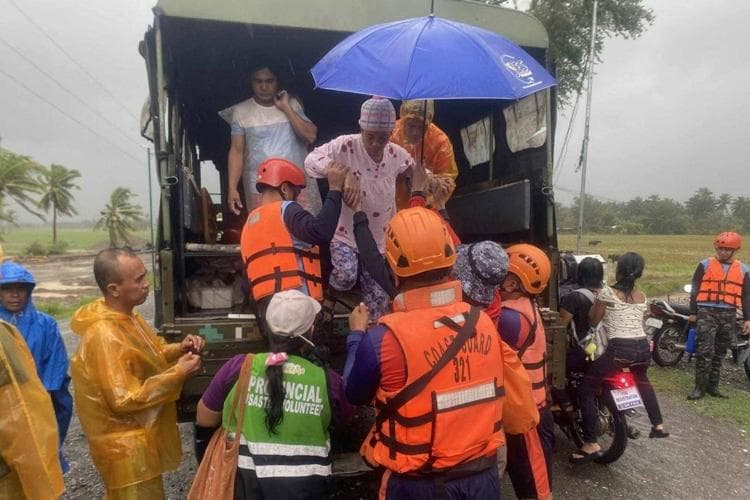We're loading the full news article for you. This includes the article content, images, author information, and related articles.
The powerful storm, known locally as Uwan, has caused widespread destruction across the Philippines, raising crucial questions about disaster preparedness and climate resilience for vulnerable nations, including Kenya.

Super Typhoon Fung-wong, locally named Uwan, slammed into the Philippines on Sunday, November 9, 2025, unleashing destructive winds and torrential rain that have led to at least two fatalities and the displacement of over 1.4 million people. The storm made landfall in Dinalungan, Aurora province, on the populous island of Luzon, at approximately 9:10 PM local time (4:10 PM EAT) with sustained winds of 185 km/h and gusts reaching 230 km/h, according to the Philippine Atmospheric, Geophysical and Astronomical Services Administration (PAGASA).
The National Disaster Risk Reduction and Management Council (NDRRMC) confirmed on Monday, November 10, that the dead included one person who drowned in Catanduanes and another killed by a collapsed house in Catbalogan City, Samar. Reports from the Office of Civil Defense (OCD) indicate that 836,572 people have been affected across multiple regions, with over 317,000 individuals taking shelter in 6,069 evacuation centers. The sheer scale of the storm, with a diameter of about 1,800 kilometers, has impacted a vast portion of the archipelago.
This disaster strikes just days after Typhoon Kalmaegi (known locally as Tino) caused significant devastation, killing at least 224 people. In response to the successive crises, Philippine President Ferdinand Marcos Jr. declared a state of emergency to expedite relief and response operations.
The typhoon has caused extensive disruption to infrastructure, with power outages reported in 170 cities and municipalities. Communication lines have also been severed in at least 14 municipalities. Transportation has been severely affected, with at least 325 domestic and 61 international flights cancelled over the weekend. The Philippine Coast Guard reported that over 7,200 passengers and workers were stranded at 156 ports as sea travel was suspended.
Philippine authorities undertook massive preemptive evacuations, moving more than 1.1 million people from high-risk areas ahead of the storm's landfall. The government has mobilized extensive resources for search, rescue, and relief operations, with 894 composite teams deployed and an additional 3,497 on standby, as reported by the OCD. The Department of Social Welfare and Development has made available P2.6 billion in standby funds and stockpiles for relief efforts.
While there are no direct impacts on Kenya from Typhoon Fung-wong, the event offers critical insights into disaster management and climate change adaptation. The Philippines, like many parts of East Africa, is highly vulnerable to extreme weather events, which scientists have found are increasing in intensity and frequency due to the climate crisis. The Philippines is hit by an average of 20 typhoons annually.
The proactive, large-scale evacuation measures implemented by the Philippine government serve as a key lesson in mitigating casualties during such disasters. For Kenya, which faces its own climate-related challenges such as flooding and droughts, the importance of robust early warning systems and well-organized evacuation plans is paramount. The World Food Programme (WFP) has been actively involved in the Philippines, providing cash assistance to thousands of households ahead of the storm, a strategy that could be adapted for disaster response in the East African region.
Bilateral relations between Kenya and the Philippines have been growing, with discussions focused on expanding trade and investment in sectors like renewable energy and tourism. According to 2020 data, a community of around 800 Kenyans, including students, resides in the Philippines. The Philippine Embassy in Nairobi has not released any statements regarding the status of Kenyan nationals affected by the typhoon. FURTHER INVESTIGATION REQUIRED.
As Fung-wong weakens and moves north towards Taiwan, the full extent of the damage in the Philippines is still being assessed. The focus remains on rescue, relief, and the long road to recovery for the hundreds of thousands affected by this powerful storm.
Keep the conversation in one place—threads here stay linked to the story and in the forums.
Other hot threads
E-sports and Gaming Community in Kenya
Active 7 months ago
Popular Recreational Activities Across Counties
Active 7 months ago
The Role of Technology in Modern Agriculture (AgriTech)
Active 7 months ago
Investing in Youth Sports Development Programs
Active 7 months ago